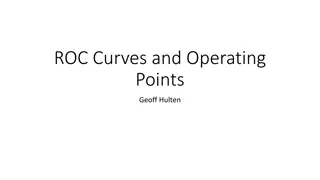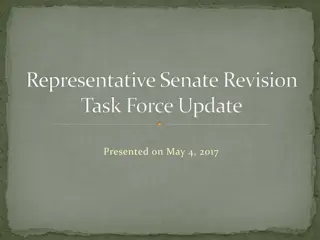Implications of Changing Demand and Supply of New Teacher Graduates for Educational Institutions in the Next Decade
Changes in the demand and supply of new teacher graduates will have significant implications for universities and schools in the coming decade. The Excel model discussed in the content focuses on various scenarios and key messages related to GDP growth assumptions. It highlights the evolution of the model from its initial version to the latest versions, emphasizing the need for iterative development and detailed analyses to inform future scenarios.
Download Presentation

Please find below an Image/Link to download the presentation.
The content on the website is provided AS IS for your information and personal use only. It may not be sold, licensed, or shared on other websites without obtaining consent from the author.If you encounter any issues during the download, it is possible that the publisher has removed the file from their server.
You are allowed to download the files provided on this website for personal or commercial use, subject to the condition that they are used lawfully. All files are the property of their respective owners.
The content on the website is provided AS IS for your information and personal use only. It may not be sold, licensed, or shared on other websites without obtaining consent from the author.
E N D
Presentation Transcript
What do changes in the demand and supply of new teacher graduates mean for universities and schools over the next decade? Martin Gustafsson Work as at May 2023
CONTENTS Excel model: What s done, what remains GDP growth assumptions revisited Six scenarios Key messages
EXCEL MODEL: WHATS DONE, WHAT REMAINS Won t go into much detail regarding the model, but details available at https://tdd.sun.ac.za/
EXCEL MODEL: WHATS DONE, WHAT REMAINS (contd.) Sep 2022 version A basically fixed version of the original 2012 Unicef model . Some internal peer-reviewing. Used for various policy briefs discussed in Nov Kievietskroon meeting. Dec 2022 version Incorporated key fixes to promotion process. Used for provincial scenarios begun in Feb 2022 and presented at this meeting. Jun (final) 2023 version Better differentiation between first-time joiners and other joiners in the outputs. New process On-the-job qualification . New version has been used for YouTube video. Could result in new provincial scenarios, but perhaps not necessary.
EXCEL MODEL: WHATS DONE, WHAT REMAINS (contd.) 18-minute video attempting to explain dynamics that are easily confusing.
EXCEL MODEL: WHATS DONE, WHAT REMAINS (contd.) What the Excel model does not do: Model future enrolments based on e.g. grade repetition (relatively straightforward learner demographic inputs used instead). Translate first-time joiners to total graduates demanded, taking into account recent reserve stock (separate modelling for this). Model breakdowns by province, school level (or gender). But if sub-system input data are used, then sub-system is modelled, e.g. as in our provincial analyses. Model breakdowns by curriculum phase or subject. Lack of sufficient input data means this must be modelled at a higher level, e.g. as in 2020 DHET report.
EXCEL MODEL: WHATS DONE, WHAT REMAINS (contd.) Lessons learnt: At least 70% of the time is spent not on the model, but on producing background historical analyses that can inform the model. So, questions about the future prompt new analyses of the past. Excel VBA does the job well, but the coding and de-bugging is time- consuming. Careful iteration between model development, generation of scenarios, discussion of scenarios, then back to model development, is unavoidable. Process is not linear. Complexity within one model has to be manageable (law of parsimony). Can be good to have several inter-related models.
GDP GROWTH ASSUMPTIONS REVISITED Historically in range 2.9% to 3.5% (was 3.0% in 2007). Despite complexities such as debt servicing, it is fairly safe to assume that GDP growth will largely determine how much we can spend on educators in future, and therefore how many we should train now.
GDP GROWTH ASSUMPTIONS REVISITED (contd.) 1.8% growth projected for 2025. But Treasury s one-year- back forecasts have been 1.4 percentage points too high in 2006 to 2019 period.
GDP GROWTH ASSUMPTIONS REVISITED (contd.) 1.8% growth projected for 2024. IMF s one-year-back forecasts have been 0.8 percentage points too high in 2006 to 2019 period.
SIX SCENARIOS Important addition is this modelling of the new reserve stock of educators, which could provide universities some breathing room .
SIX SCENARIOS (contd.) Key finding of the modelling is that even with 1.5% notch progression, average unit cost growth in real terms is near zero (with CPI-linked CoL increases). Roughly, from most to least desirable. If strong growth, or some other factor, increases young attrition, a very different university challenge. With extremely low growth, growing the workforce would require below-inflation CoL increases (but notch progression remains unaffected here). Undesirable. Implies e.g. pushing 360,000 foundation phase learners above class size 40 threshold. 1.8% growth would be compatible with necessary 16% increase in workforce. 6% workforce growth, perhaps more feasible in a context of infrastructure constraints.
KEY MESSAGES We need to become more conscious of LE ratios and class sizes, and stop thinking of workforce size as a fixed constant. The debates around learning improvements have tended to ignore the class size problem. Both workforce growth and better management must address excessive class sizes. We don t know enough about the interactions yet, but considerable workforce growth is inescapable. Even with post-2019 declines in real value of notches, notches in 2024 will be 17% higher in inflation-adjusted terms than 2008 notches. CPI-linked notch (CoL) increases should be viewed in this light. Needed workforce growth with notch progression possible, even with very weak economic growth, if notch values are CPI-linked.























